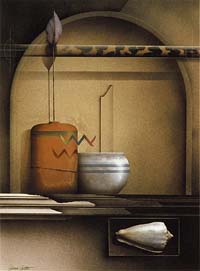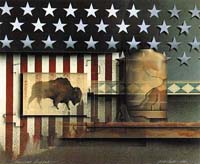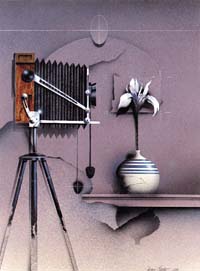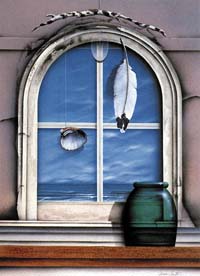|
Carter
by James Carter
Hard Cover, 168 pages
Art.
ISBN - 0-941393-18-6
Click on the pages to the left for high-quality PDF images of this book.
James Carter, the contemporary American artist, combines the dream images of surrealism with the techniques of superrealism to create still lifes with distinctly American roots. His acrylic and airbrush techniques give us a fresh view of familiar things. Like Magritte, Carter delights in juxtaposing unexpected objects. The animate and inanimate appear together. By placing a real object in abstract environments, Carter can make them dissolve, fade, float or move in any way he wishes. Eggs are suspended from wires; pottery fragments sit upright on shelves, camels float in the air. From childhood, he has been fascinated by collections of natural objects. He assembles small collections in his works and dramatizes them by placing them on a mantel or in a box. "I use the mantel as a stage," Carter says, "It's almost like a backdrop to a play. Then the objects become the figures or characters.

In addition to studying at the Silvermine College of Art in New Canaan, Connecticut and the Maryland Institute of Art, James Carter considered becoming an architect. He found that working with line and form, however, was more important to him than creating buildings. His architectural training is evident in his clearly structured compositions, as well as in the use of architectural details in his work, including mantels, and doorways, graph-like grids and crosshatchings as ween through surveyors' instruments. The crosshatches provide focal points for the eye.

The media he uses - arcrylic with airbrush, serigraphy and lithography - are conducive to the soft, subdued, translucent and prcise quality Carter wants to achieve. In Germany, hs studied the painting and printmaking of Paul Wunderlich, one of the few fine artists then working with airbrush. "Airbrush is such a great tool, because you can get tones and textures which can't be achieved with a brush," Carter says. He enjoys the exacting nature of airbrush and the fact that it lends itself so well to the depiction of sea and sky.

The interplay of light and shadows is also important in Carter's work. Although he says that color is secondary to him - that he uses it to add perspective and depth, rather than out of primary concern for color itself - his complex and subtle use of color is valued by collectors of his work.

All in all Carter is drawn to the spectrum of medium with the tacit curiosity innate in creative personalities. His vision, his cachet, if you will, is uniquely James Carter.
|

